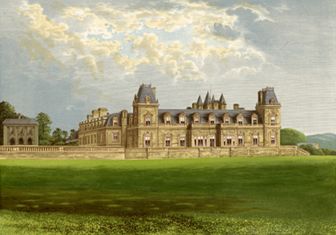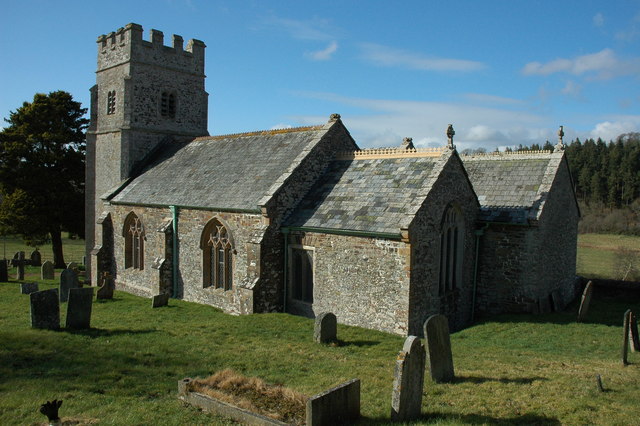|
Manor Of Bicton
The Manor of Bicton is an historic Manorialism, manor in the parish of Bicton, Devon, Bicton in east Devon, England. Descent of the manor Porter In the Exchequer version of the Domesday Book of 1086, the manor of ''Bechetone'' was listed as the 1st of the 16 holdings under the heading ''Terrae Servientium Regis'' ("Lands of the King's servants"). It was held tenant-in-chief, in-chief from the king (by feudal land tenure, service unknown) by ''Wills Porto'', that is "William the Porter (doorkeeper), Porter", meaning "gatekeeper" (from the Latin ''porta'' a gate). In the Exon version of Domesday Book however this manor is listed with the same tenant, but under the heading ''Terra Nicolai Balistarii'' ("Land of Nicholas the Bowman"), thus William held not as a tenant-in-chief but as a mesne tenant from Nicholas. Nicholas also held the manors of Webbery, Greenslinch, Stoketeignhead, Rocombe, Ogwell, Holbeam, Bagtor, Ideford, Staplehill, Buckland-in-the-Moor, Aller and possibly Northle ... [...More Info...] [...Related Items...] OR: [Wikipedia] [Google] [Baidu] |
Manorialism
Manorialism, also known as the manor system or manorial system, was the method of land ownership (or "tenure") in parts of Europe, notably France and later England, during the Middle Ages. Its defining features included a large, sometimes fortified manor house in which the lord of the manor and his dependents lived and administered a rural estate, and a population of labourers who worked the surrounding land to support themselves and the lord. These labourers fulfilled their obligations with labour time or in-kind produce at first, and later by cash payment as commercial activity increased. Manorialism is sometimes included as part of the feudal system. Manorialism originated in the Roman villa system of the Late Roman Empire, and was widely practiced in medieval western Europe and parts of central Europe. An essential element of feudal society, manorialism was slowly replaced by the advent of a money-based market economy and new forms of agrarian contract. In examining the o ... [...More Info...] [...Related Items...] OR: [Wikipedia] [Google] [Baidu] |
List Of Latinized Names
The Latinisation of names in the vernacular was a procedure deemed necessary for the sake of conformity by scribes and authors when incorporating references to such persons in Latin texts. The procedure was used in the era of the Roman Republic and Empire. It was used continuously by the Papacy from the earliest times, in religious tracts and in diplomatic and legal documents. It was used by the early European monasteries. Following the Norman Conquest of England, it was used by the Anglo-Norman clerics and scribes when drawing up charters. Its use was revived in the Renaissance when the new learning was written down in Latin and drew much on the work of Greek, Arabic and other non-Latin ancient authors. Contemporary Italian and European scholars also needed to be Latinised to be quoted in such treatises. The different eras produced their own styles and peculiarities. Sophistication was the trademark of the Renaissance Latinisers. The Anglo-Norman scribes on the other hand were not ... [...More Info...] [...Related Items...] OR: [Wikipedia] [Google] [Baidu] |
Sir Arthur Mainwaring
Sir Arthur Mainwaring (c. 1580 – 1648) was an English politician who sat in the House of Commons from 1624 to 1626. Life Mainwaring was the eldest son of Sir George Mainwaring of Ightfield, Shropshire and Ann More, daughter of William More. He was awarded BA from Brasenose College, Oxford on 7 July 1598 and MA on 15 June 1601. He began a rise to prominence working for Sir Thomas Egerton, in whose household he was steward from 1602 to 1617. John Payne Collier published records by Mainwaring relating to a performance of ''Othello'' for Queen Elizabeth at this period; these were later recognised as forgeries, however. A genuine connection with William Shakespeare was an attempt led by Mainwaring in 1614 to enclose lands at Welcombe near Stratford-upon-Avon, defeated by local resistance. He was described as of Cheshire when he was knighted at the London Charterhouse on 11 May 1603. Mainwaring also and concurrently became a courtier, carver in the household of Henry Freder ... [...More Info...] [...Related Items...] OR: [Wikipedia] [Google] [Baidu] |
Stevenstone
Stevenstone is a former manor within the parish of St Giles in the Wood, near Great Torrington Great Torrington (often abbreviated to Torrington, though the villages of Little Torrington and Black Torrington are situated in the same region) is a market town in Devon, England. Parts of it are sited on high ground with steep drops down to ..., North Devon. It was the chief seat of the Rolle family, one of the most influential and wealthy of Devon families, from c. 1524 until 1907. The Rolle estates as disclosed by the Return of Owners of Land, 1873 (corrected by Bateman's 'Great Landowners' (1883), Bateman, 1883) comprised 55,592 acres producing an annual gross income of £47,170, and formed the largest estate in Devon, followed by the Francis Russell, 9th Duke of Bedford, Duke of Bedford's estate centred on Tavistock, Devon, Tavistock comprising 22,607 with an annual gross value of nearly £46,000. From the Glorious Revolution of 1688 to the Reform Act of 1832 the coun ... [...More Info...] [...Related Items...] OR: [Wikipedia] [Google] [Baidu] |
William Paulet, 3rd Marquis Of Winchester
William is a masculine given name of Norman French origin.Hanks, Hardcastle and Hodges, ''Oxford Dictionary of First Names'', Oxford University Press, 2nd edition, , p. 276. It became very popular in the English language after the Norman conquest of England in 1066,All Things William"Meaning & Origin of the Name"/ref> and remained so throughout the Middle Ages and into the modern era. It is sometimes abbreviated "Wm." Shortened familiar versions in English include Will, Wills, Willy, Willie, Liam, Bill, and Billy. A common Irish form is Liam. Scottish diminutives include Wull, Willie or Wullie (as in Oor Wullie or the play ''Douglas''). Female forms are Willa, Willemina, Wilma and Wilhelmina. Etymology William is related to the German given name ''Wilhelm''. Both ultimately descend from Proto-Germanic ''*Wiljahelmaz'', with a direct cognate also in the Old Norse name ''Vilhjalmr'' and a West Germanic borrowing into Medieval Latin ''Willelmus''. The Proto-Germanic name is a ... [...More Info...] [...Related Items...] OR: [Wikipedia] [Google] [Baidu] |
Anne Of Cleves
Anne of Cleves (german: Anna von Kleve; 1515 – 16 July 1557) was Queen of England from 6 January to 12 July 1540 as the fourth wife of King Henry VIII. Not much is known about Anne before 1527, when she became betrothed to Francis, Duke of Bar, son and heir of Antoine, Duke of Lorraine, although their marriage did not proceed. In March 1539, negotiations for Anne's marriage to Henry began, as Henry believed that he needed to form a political alliance with her brother, William, who was a leader of the Protestants of western Germany, to strengthen his position against potential attacks from Catholic France and the Holy Roman Empire. Anne arrived in England on 27 December 1539 and married Henry on 6 January 1540, but after six months, the marriage was declared unconsummated and, as a result, she was not crowned queen consort. Following the annulment, Henry gave her a generous settlement, and she was thereafter known as ''the King's Beloved Sister''. Remaining in England, she ... [...More Info...] [...Related Items...] OR: [Wikipedia] [Google] [Baidu] |
Orangery
An orangery or orangerie was a room or a dedicated building on the grounds of fashionable residences of Northern Europe from the 17th to the 19th centuries where orange and other fruit trees were protected during the winter, as a very large form of greenhouse or conservatory. The orangery provided a luxurious extension of the normal range and season of woody plants, extending the protection which had long been afforded by the warmth offered from a masonry fruit wall. During the 17th century, fruits like orange, pomegranate, and bananas arrived in huge quantities to European ports. Since these plants were not adapted to the harsh European winters, orangeries were invented to protect and sustain them. The high cost of glass made orangeries a status symbol showing wealth and luxury. Gradually, due to technological advancements, orangeries became more of a classic architectural structure that enhanced the beauty of an estate garden, rather than a room used for wintering pla ... [...More Info...] [...Related Items...] OR: [Wikipedia] [Google] [Baidu] |
Eggesford
Eggesford () is a parish in mid-Devon, without its own substantial village. It is served by Eggesford railway station on the Exeter to Barnstaple railway line, also known as the Tarka Line. Descent of the Manor de Reigny The manor of Eggesford is not recorded in the Domesday Book of 1086. In 1233 it was held by Sir John de Reigny, whose family, nearly all the male heirs of which were called John or Richard, remained in possession for many generations. In the 15th century Ibota, the widow of John Reigny, built an almshouse within the parish, which was valued in 1547 at £4 10s 6d per annum. No trace of the building remains and its location is unknown. Copleston In the 16th century the male line of Reigny died out, and Anne Reigny (daughter and sole-heiress of Richard Reigny) brought the manor to the family of her husband, Charles Copleston of Bicton. Their son was John I Copleston (died 1586), who is recorded as patron of the church in 1571. As a mural tablet in Eggesford Chu ... [...More Info...] [...Related Items...] OR: [Wikipedia] [Google] [Baidu] |
Copplestone
Copplestone (anciently Copelaston, Coplestone etc.) is a village, former manor and civil parish in Mid Devon in the English county of Devon. It is not an ecclesiastical parish as it has no church of its own, which reflects its status as a relatively recent settlement which grew up around the ancient "Copleston Cross" (see below) that stands at the junction of the three ancient ecclesiastical parishes of Colebrooke, Crediton and Down St Mary. The small parish is surrounded clockwise from the north by the parishes of Sandford, Crediton Hamlets, Colebrooke, Clannaborough, and Down St Mary. According to the 2001 census the parish had a population of 894, increasing to 1,253 in 2011. It is situated right in the middle of Devon halfway between Exeter and Barnstaple on the A377, nestled in a valley. ''Copplestone'' is a major part of the Yeo electoral ward whose total ward population was 3,488 at the above census. The Tarka Line railway goes through the middle of the villa ... [...More Info...] [...Related Items...] OR: [Wikipedia] [Google] [Baidu] |






